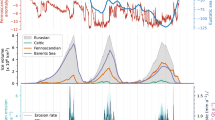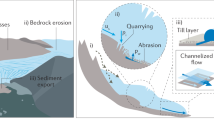Abstract
Glaciers often erode, transport and deposit sediment much more rapidly than nonglacial environments1, with implications for the evolution of glaciated mountain belts and their associated sedimentary basins. But modelling such glacial processes is difficult, partly because stabilizing feedbacks similar to those operating in rivers2,3 have not been identified for glacial landscapes. Here we combine new and existing data of glacier morphology and the processes governing glacier evolution from diverse settings to reveal such stabilizing feedbacks. We find that the long profiles of beds of highly erosive glaciers tend towards steady-state angles opposed to and slightly more than 50 per cent steeper than the overlying ice–air surface slopes, and that additional subglacial deepening must be enabled by non-glacial processes. Climatic or glaciological perturbations of the ice–air surface slope can have large transient effects on glaciofluvial sediment flux and apparent glacial erosion rate.
This is a preview of subscription content, access via your institution
Access options
Subscribe to this journal
Receive 51 print issues and online access
$199.00 per year
only $3.90 per issue
Buy this article
- Purchase on Springer Link
- Instant access to full article PDF
Prices may be subject to local taxes which are calculated during checkout

Similar content being viewed by others
References
Hallet, B., Hunter, L. & Bogen, J. Rates of erosion and sediment evacuation by glaciers: a review of field data and their implications. Glob. Planet. Change 12, 213–235 (1996)
Mackin, J. H. Concept of the graded river. Geol. Soc. Am. Bull. 59, 463–512 (1948)
Easterbrook, D. J. Surface Processes and Landforms 2nd edn (Prentice Hall, Upper Saddle River, NJ, 1999)
Montgomery, D. R. Valley formation by fluvial and glacial erosion. Geology 30, 1047–1050 (2002)
Alley, R. B., Lawson, D. E., Evenson, E. B. & Larson, G. J. Sediment, glaciohydraulic supercooling, and fast glacier flow. Ann. Glaciol. (in the press)
Lawson, D. E. Glaciohydrologic and Glaciohydraulic Effects on Runoff and Sediment Yield in Glacierized Basins (CRREL Monograph 93–2, US Army Cold Regions Research and Engineering Laboratory, Hanover, NH, 1993)
Hunter, L. E., Powell, R. D. & Lawson, D. Flux of debris transported by ice at three Alaskan tidewater glaciers. J. Glaciol. 42, 123–135 (1996)
Alley, R. B. et al. How glaciers entrain and transport sediment at their beds: Physical constraints. Quat. Sci. Rev 16, 1017–1038 (1997)
Iverson, N. R. Potential effects of subglacial water-pressure fluctuations on quarrying. J. Glaciol. 37, 27–36 (1991)
Hallet, B. Glacial quarrying: a simple theoretical model. Ann. Glaciol 22, 1–9 (1996)
Cuffey, K. M. & Alley, R. B. Erosion by deforming subglacial sediments: Is it significant? (Toward till continuity). Ann. Glaciol 22, 126–133 (1996)
Hooke, R. & Le, B. Positive feedbacks associated with erosion of glacial cirques and overdeepenings. Geol. Soc. Am. Bull. 34, 228–231 (1991)
Alley, R. B., Strasser, J. C., Lawson, D. E., Evenson, E. B. & Larson, G. J. in Glacial Processes Past and Present (eds Mickelson, D. M. & Attig, J. W.) 1–9 (Geol. Soc. Am. Spec. Pap. 337, Boulder, CO, 1999)
Röthlisberger, H. & Lang, H. in Glaciofluvial Sediment Transfer–An Alpine Perspective (eds Gurnell, A. M. & Clark, M. J.) 207–284 (Wiley, New York, 1987)
Hooke, R., Le, B. & Pohjola, V. A. Hydrology of a segment of a glacier situated in an overdeepening, Storglaciaren, Sweden. J. Glaciol. 40, 140–148 (1994)
Alley, R. B., Lawson, D. E., Evenson, E. B., Srasser, J. C. & Larson, G. J. Glaciohydraulic supercooling: A freeze-on mechanism to create stratified, debris-rich basal ice. 2. Theory. J. Glaciol. 44, 563–569 (1998)
Lliboutry, L. Modifications to the theory of intraglacial waterways for the case of subglacial ones. J. Glaciol. 29, 216–226 (1983)
Lawson, D. E. et al. Glaciohydraulic supercooling: A freeze-on mechanism to create stratified, debris-rich basal ice. 1. Field evidence and conceptual model. J. Glaciol 44, 547–562 (1998)
Brocklehurst, S. H. & Whipple, K. X. Glacial erosion and relief production in the Eastern Sierra Nevada, California. Geomorphology 42, 1–24 (2002)
Roberts, M. J. et al. Glaciohydraulic supercooling in Iceland. Geology 30, 439–442 (2002)
Nolan, M., Motyka, R. J., Echelmeyer, K. & Trabant, D. C. Ice-thickness measurements of Taku Glacier, Alaska, USA, and their relevance to its recent behavior. J. Glaciol. 41, 541–553 (1995)
Hall, D. K., Benson, C. S. & Field, W. O. Changes of glaciers in Glacier Bay, Alaska, using ground and satellite measurements. Phys. Geogr. 16, 27–41 (1995)
Koppes, M. N. & Hallet, B. Influence of rapid glacial retreat on the rate of erosion by tidewater glaciers. Geology 30, 47–50 (2002)
Arcone, S. A., Lawson, D. E., Delaney, A. J. & Moran, M. in 8th Int. Conf. Ground-Penetrating Radar (eds Noon, D. A., Stickley, G. F. & Longstaff, D.) 377–382 (SPIE, Bellingham, WA, 2000)
Powell, R. D. in Glacimarine Environments, Processes and Sediments (eds Dowdeswell, J. A. & Scourse, J. D.) 53–73 (Geol. Soc. Lond. Spec. Pub. No. 53, London, 1990)
Williams, J. R. & Ferrians, O. J. Late Wisconsinan and recent history of the Matanuska Glacier, Alaska. Arctic 14, 82–90 (1961)
Lawson, D. E. Sedimentological Analysis of the Western Terminus Region of the Matanuska Glacier, Alaska (CRREL Report 79–9, US Army Cold Regions Research and Engineering Laboratory, Hanover, NH, 1979)
Evenson, E. B. et al. in Glacial Processes Past and Present (eds Mickelson, D. M. & Attig, J. W.) 23–25 (Geol. Soc. Am. Spec. Pap. 337, Boulder, CO, 1999)
Pearce, J. T. et al. Bedload component of glacially discharged sediment: Insights from the Matanuska Glacier, Alaska. Geology 31, 7–10 (2003)
Linker, J. S. et al. Suspended sediment flux as an indicator for rate of glacial erosion at the Matanuska Glacier, south-central Alaska. Geol. Soc. Am. Abstr. Prog. 32, A329 (2000)
Acknowledgements
We thank K. Cuffey for advice and for comments on this manuscript, including help with the third paragraph. We thank our many colleagues in studying the Matanuska glacier system, including S. Arcone, S. Kopczynski, R. Bigl, J. Denner, S. Ensminger, T. Johnston and J. Strasser, and we thank R. Hooke for suggestions. Discussions with B. Hallet, G. Clarke, T. Creyts, S. Tulaczyk and other colleagues helped clarify our ideas. We thank NSF and CRREL for funding.Author contributions R.B.A. led collaborative theory development and writing, D.E.L., G.J.L. and E.B.E. provided extensive data and insights on glacier processes, and G.S.B. produced new geophysical data at Matanuska glacier.
Author information
Authors and Affiliations
Corresponding author
Ethics declarations
Competing interests
The authors declare that they have no competing financial interests.
Rights and permissions
About this article
Cite this article
Alley, R., Lawson, D., Larson, G. et al. Stabilizing feedbacks in glacier-bed erosion. Nature 424, 758–760 (2003). https://doi.org/10.1038/nature01839
Received:
Accepted:
Issue Date:
DOI: https://doi.org/10.1038/nature01839
This article is cited by
-
The extreme yet transient nature of glacial erosion
Nature Communications (2022)
-
The impact of glaciers on mountain erosion
Nature Reviews Earth & Environment (2021)
-
Unravelling the shape and stratigraphy of a glacially-overdeepened valley with reflection seismic: the Lienz Basin (Austria)
Swiss Journal of Geosciences (2019)
-
Metagenomic analysis of basal ice from an Alaskan glacier
Microbiome (2018)
-
Antarctica's lost landscape
Nature Geoscience (2013)
Comments
By submitting a comment you agree to abide by our Terms and Community Guidelines. If you find something abusive or that does not comply with our terms or guidelines please flag it as inappropriate.



